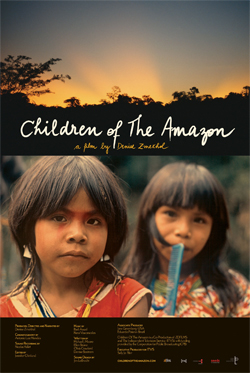Zmekhol focuses on a group of Surui children she photographed 15 years ago to show the rapid cultural change that is occurring in indigenous communities at the frontier of development in the Brazilian Amazon. She illustrates the story through recent interviews with the children, who are now young adults; video shot of their village and the region in the late 1980s when colonists first started arriving in the region; archival footage of the Surui and Negarote tribes shortly after contact in the late 1960s; and the story of Chico Mendes, a rubber tapper union who was assassinated after famously battling ranchers and loggers in the late 1980s and laying the groundwork for the effort to save the Amazon rainforest. While the story is a depressing one for those who wish to see the Amazon conserved and the rights of indigenous people respected, 'Children of the Amazon' aims to end on an upbeat note by focusing on heroic efforts among the Surui to protect their forest homeland from developers—today the tribe is working with rubber tappers, innovative conservationists, and even Internet giant Google to preserve forests and its culture.


No comments:
Post a Comment